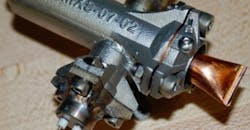UV LED Stimulates Calibrated, Fully Controllable X-Ray Source
Applications such as science and space spectroscopy need a known source for self-calibration before measuring the energy of incident X-rays, and most in-flight X-ray detectors use a radioactive source for this due to its stability. However, besides the obvious associated with a radioactive source, it requires shielding so that its constant output doesn’t appear as background noise, which masks the desired signal.
Other approaches also have their weaknesses. The hot cathode-based advanced MXS systems can generally only vary its output intensity relatively slowly—on the order of seconds—due to the thermal time constant of the filament X-ray source (Fig. 1).
1. Conventional X-ray sources use a heated filament with on/off transition times of several seconds. (Source: NASA)
Another option, the laser-based femtosecond source, can’t produce X-ray flux having arbitrary, continuously variable output intensity because its driving laser has minimum pulse-recovery and recycling time. Finally, architectures using high-efficiency photocathodes have excessive “dark current” (electron emission despite lack of stimulating light). As a result, they’re never fully off, have high power consumption, and experience early cathode burnout, among negatives.
Consequently, there’s a need for an X-ray source (MXS) that can be fully and easily modulated, producing X-rays only at predetermined intervals and at a controllable rate. Now, a NASA team has devised a miniaturized X-ray source that’s “stimulated” by a UV LED and can be modulated in intensity from completely off to full intensity at sub-nanosecond rates—and with output over 100 keV (Fig. 2).
2. The UV LED-driven MXS uses photoelectrons to vary X-ray output at nanosecond rates and timing. (Source: NASA)
Its high-speed and miniature size not only meet the calibration needs of test-and-measurement setups, but also make it a good fit for new technologies including X-ray-based communication, compact time-resolved X-ray diffraction, X-ray fluorescence instruments, non-destructive testing (NDT), and precise low-dose medical X-rays,
This MXS produces electrons by directing UV light from a LED onto a photocathode material such as magnesium. The electrons are then accelerated across several kV and into a chosen target material; the sudden deceleration produces X-rays at a wavelength that’s characteristic of the target material’s properties. The MXS uses a cold-cathode electron multiplier (similar to a photomultiplier tube) for high efficiency in X-ray production.
This MXS design is more compact, rugged, and power-efficient than standard X-ray sources, and can be manufactured using commercially available components supplemented by a 3D-printed housing, lowering manufacturing costs (Fig. 3). Further, unlike traditional X-ray sources, the MXS doesn’t require a filament or vacuum and cooling systems.
3. The new miniaturized X-ray source can be modulated in intensity from fully off to full intensity, and is suitable for a wide of electronic, medical, and even space-related instrumentation systems. (Source: NASA)
Full details are available in the NASA-assigned U.S. patent US 9,117,622, “Miniaturized High-Speed Modulated X-Ray Source.”
About the Author

Bill Schweber
Contributing Editor
Bill Schweber is an electronics engineer who has written three textbooks on electronic communications systems, as well as hundreds of technical articles, opinion columns, and product features. In past roles, he worked as a technical website manager for multiple topic-specific sites for EE Times, as well as both the Executive Editor and Analog Editor at EDN.
At Analog Devices Inc., Bill was in marketing communications (public relations). As a result, he has been on both sides of the technical PR function, presenting company products, stories, and messages to the media and also as the recipient of these.
Prior to the MarCom role at Analog, Bill was associate editor of their respected technical journal and worked in their product marketing and applications engineering groups. Before those roles, he was at Instron Corp., doing hands-on analog- and power-circuit design and systems integration for materials-testing machine controls.
Bill has an MSEE (Univ. of Mass) and BSEE (Columbia Univ.), is a Registered Professional Engineer, and holds an Advanced Class amateur radio license. He has also planned, written, and presented online courses on a variety of engineering topics, including MOSFET basics, ADC selection, and driving LEDs.




